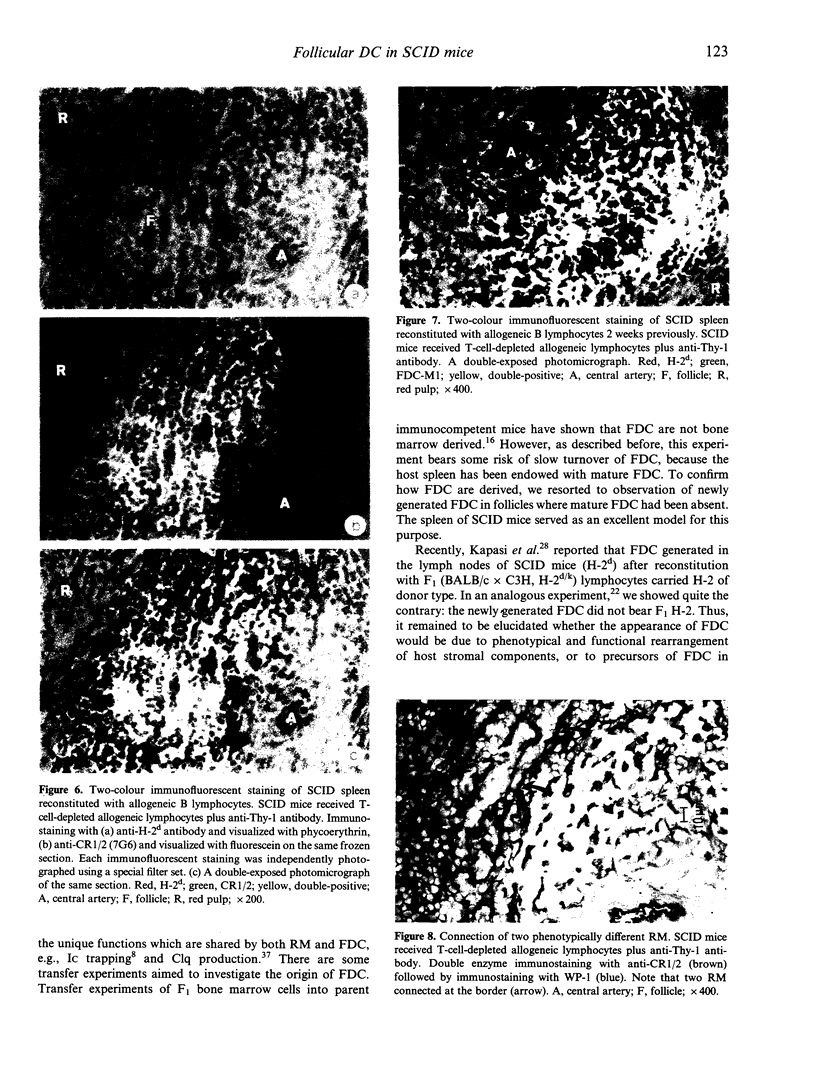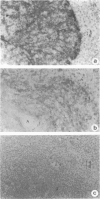Abstract
Follicular dendritic cells (FDC) are uniquely characterized by the ability to trap immune complexes. In a previous report, it was shown that functional FDC with the capacity to trap immune complexes via complement receptor emerged in the splenic follicle after transferring syngeneic lymphocytes into the severe combined immunodeficiency (SCID) mouse. In the present report, we have investigated whether FDC are derived from haematopoietic cells or surrounding stromal components, by transferring allogeneic lymphocytes into SCID mice. Transfer of allogeneic T and B lymphocytes (H-2k) into SCID(H-2d) mice, however, failed to induce the development of FDC in the splenic white pulp. This was due to a graft-versus-host reaction (GVHR) by allogeneic lymphocytes against host stromal cells, as revealed by the destruction of the splenic reticular meshwork. The GVHR was prevented in transfer experiments of T-cell-depleted allogeneic lymphocytes with daily administration of anti-Thy-1 antibody. This resulted in segregated lodgement of allogeneic B lymphocytes in the proper compartments and, thereafter, generation of FDC in the primary follicle of SCID spleen, as revealed by the trapped immune complexes via complement receptors. The H-2 of the newly generated FDC was examined by two-colour immunofluorescent staining. FDC were defined as the reticular cells stained with anti-CR1/2 or FDC-M1 antibodies. FDC carried host H-2, clearly indicating that newly generated FDC are host-derived. In addition, the FDC shared the BP-3 protein with the surrounding reticular cells, a specific marker of reticular meshwork in the murine lymphoid tissues, and formed a network continuous with the rest of the reticulum, suggesting that FDC and non-FDC reticular cells belong to the same cell lineage.
Full text
PDF









Images in this article
Selected References
These references are in PubMed. This may not be the complete list of references from this article.
- Bosma G. C., Custer R. P., Bosma M. J. A severe combined immunodeficiency mutation in the mouse. Nature. 1983 Feb 10;301(5900):527–530. doi: 10.1038/301527a0. [DOI] [PubMed] [Google Scholar]
- Cerny A., Zinkernagel R. M., Groscurth P. Development of follicular dendritic cells in lymph nodes of B-cell-depleted mice. Cell Tissue Res. 1988 Nov;254(2):449–454. doi: 10.1007/BF00225818. [DOI] [PubMed] [Google Scholar]
- Dijkstra C. D., Döpp E. A. Ontogenetic development of T- and B-lymphocytes and non-lymphoid cells in the white pulp of the rat spleen. Cell Tissue Res. 1983;229(2):351–363. doi: 10.1007/BF00214978. [DOI] [PubMed] [Google Scholar]
- Dijkstra C. D., Kamperdijk E. W., Döpp E. A. The ontogenetic development of the follicular dendritic cell. An ultrastructural study by means of intravenously injected horseradish peroxidase (HRP)-anti-HRP complexes as marker. Cell Tissue Res. 1984;236(1):203–206. doi: 10.1007/BF00216532. [DOI] [PubMed] [Google Scholar]
- Dorshkind K., Denis K. A., Witte O. N. Lymphoid bone marrow cultures can reconstitute heterogeneous B and T cell-dependent responses in severe combined immunodeficient mice. J Immunol. 1986 Dec 1;137(11):3457–3463. [PubMed] [Google Scholar]
- Ferrara J. L., Deeg H. J. Graft-versus-host disease. N Engl J Med. 1991 Mar 7;324(10):667–674. doi: 10.1056/NEJM199103073241005. [DOI] [PubMed] [Google Scholar]
- Gerdes J., Stein H., Mason D. Y., Ziegler A. Human dendritic reticulum cells of lymphoid follicles: their antigenic profile and their identification as multinucleated giant cells. Virchows Arch B Cell Pathol Incl Mol Pathol. 1983;42(2):161–172. doi: 10.1007/BF02890379. [DOI] [PubMed] [Google Scholar]
- Gray D., Skarvall H. B-cell memory is short-lived in the absence of antigen. Nature. 1988 Nov 3;336(6194):70–73. doi: 10.1038/336070a0. [DOI] [PubMed] [Google Scholar]
- Groscurth P. Nicht-lymphatische Zellen in der Lymphknotenrinde der Maus. II. Postnatale Entwicklung der interdigitierenden Zellen und der dendritischen Retikulumzellen. Pathol Res Pract. 1980 Nov;169(3-4):235–254. doi: 10.1016/s0344-0338(80)80003-3. [DOI] [PubMed] [Google Scholar]
- Heusermann U., Zurborn K. H., Schroeder L., Stutte H. J. The origin of the dendritic reticulum cell. An experimental enzyme-histochemical and electron microscopic study on the rabbit spleen. Cell Tissue Res. 1980;209(2):279–294. doi: 10.1007/BF00237632. [DOI] [PubMed] [Google Scholar]
- Humphrey J. H., Grennan D., Sundaram V. The origin of follicular dendritic cells in the mouse and the mechanism of trapping of immune complexes on them. Eur J Immunol. 1984 Sep;14(9):859–864. doi: 10.1002/eji.1830140916. [DOI] [PubMed] [Google Scholar]
- Itoh J., Kinjoh K., Ohyama A., Nose M., Kyogoku M. Application of two-color immunofluorescence staining to demonstration of T-cells and HLA-DR-bearing cells in rheumatoid synovitis. J Histochem Cytochem. 1992 Nov;40(11):1675–1683. doi: 10.1177/40.11.1431056. [DOI] [PubMed] [Google Scholar]
- Johnson G. D., Hardie D. L., Ling N. R., Maclennan I. C. Human follicular dendritic cells (FDC): a study with monoclonal antibodies (MoAb). Clin Exp Immunol. 1986 Apr;64(1):205–213. [PMC free article] [PubMed] [Google Scholar]
- Kapasi Z. F., Burton G. F., Shultz L. D., Tew J. G., Szakal A. K. Cellular requirements for functional reconstitution of follicular dendritic cells in SCID mice. Adv Exp Med Biol. 1993;329:383–386. doi: 10.1007/978-1-4615-2930-9_64. [DOI] [PubMed] [Google Scholar]
- Kapasi Z. F., Burton G. F., Shultz L. D., Tew J. G., Szakal A. K. Induction of functional follicular dendritic cell development in severe combined immunodeficiency mice. Influence of B and T cells. J Immunol. 1993 Apr 1;150(7):2648–2658. [PubMed] [Google Scholar]
- Kinoshita T., Takeda J., Hong K., Kozono H., Sakai H., Inoue K. Monoclonal antibodies to mouse complement receptor type 1 (CR1). Their use in a distribution study showing that mouse erythrocytes and platelets are CR1-negative. J Immunol. 1988 May 1;140(9):3066–3072. [PubMed] [Google Scholar]
- Klaus G. G., Humphrey J. H., Kunkl A., Dongworth D. W. The follicular dendritic cell: its role in antigen presentation in the generation of immunological memory. Immunol Rev. 1980;53:3–28. doi: 10.1111/j.1600-065x.1980.tb01038.x. [DOI] [PubMed] [Google Scholar]
- Knulst A. C., Bril-Bazuin C., Benner R. Prevention of lethal graft-vs.-host disease by a single low dose injection of anti-T cell monoclonal antibody to the allograft recipients. Eur J Immunol. 1991 Jan;21(1):103–107. doi: 10.1002/eji.1830210116. [DOI] [PubMed] [Google Scholar]
- Kosco M. H., Pflugfelder E., Gray D. Follicular dendritic cell-dependent adhesion and proliferation of B cells in vitro. J Immunol. 1992 Apr 15;148(8):2331–2339. [PubMed] [Google Scholar]
- Kunkl A., Klaus G. G. The generation of memory cells. IV. Immunization with antigen-antibody complexes accelerates the development of B-memory cells, the formation of germinal centres and the maturation of antibody affinity in the secondary response. Immunology. 1981 Jun;43(2):371–378. [PMC free article] [PubMed] [Google Scholar]
- Kuppers R. C., Suiter T., Gleichmann E., Rose N. R. The induction of organ-specific antibodies during the graft-vs.-host reaction. Eur J Immunol. 1988 Jan;18(1):161–166. doi: 10.1002/eji.1830180124. [DOI] [PubMed] [Google Scholar]
- Maeda M., Muro H., Shirasawa H. C1q production and C1q-mediated immune complex retention in lymphoid follicles of rat spleen. Cell Tissue Res. 1988;254(3):543–551. doi: 10.1007/BF00226504. [DOI] [PubMed] [Google Scholar]
- Mandel T. E., Phipps R. P., Abbot A., Tew J. G. The follicular dendritic cell: long term antigen retention during immunity. Immunol Rev. 1980;53:29–59. doi: 10.1111/j.1600-065x.1980.tb01039.x. [DOI] [PubMed] [Google Scholar]
- McNagny K. M., Bucy R. P., Cooper M. D. Reticular cells in peripheral lymphoid tissues express the phosphatidylinositol-linked BP-3 antigen. Eur J Immunol. 1991 Feb;21(2):509–515. doi: 10.1002/eji.1830210238. [DOI] [PubMed] [Google Scholar]
- Reimann J., Rudolphi A., Claesson M. H. CD3+ T-cells in severe combined immunodeficiency (scid) mice. III. Transferred congenic, selfreactive CD4+ T cell clones rescue IgM-producing, scid-derived B cells. Int Immunol. 1991 Jul;3(7):657–663. doi: 10.1093/intimm/3.7.657. [DOI] [PubMed] [Google Scholar]
- Rozendaal L., Pals S. T., Melief C. J., Gleichmann E. Protection from lethal graft-vs.-host disease by donor stem cell repopulation. Eur J Immunol. 1992 Feb;22(2):575–579. doi: 10.1002/eji.1830220241. [DOI] [PubMed] [Google Scholar]
- Schriever F., Freedman A. S., Freeman G., Messner E., Lee G., Daley J., Nadler L. M. Isolated human follicular dendritic cells display a unique antigenic phenotype. J Exp Med. 1989 Jun 1;169(6):2043–2058. doi: 10.1084/jem.169.6.2043. [DOI] [PMC free article] [PubMed] [Google Scholar]
- Schuler W., Schuler A., Bosma M. J. Defective V-to-J recombination of T cell receptor gamma chain genes in scid mice. Eur J Immunol. 1990 Mar;20(3):545–550. doi: 10.1002/eji.1830200313. [DOI] [PubMed] [Google Scholar]
- Schuler W., Weiler I. J., Schuler A., Phillips R. A., Rosenberg N., Mak T. W., Kearney J. F., Perry R. P., Bosma M. J. Rearrangement of antigen receptor genes is defective in mice with severe combined immune deficiency. Cell. 1986 Sep 26;46(7):963–972. doi: 10.1016/0092-8674(86)90695-1. [DOI] [PubMed] [Google Scholar]
- Villena A., Zapata A., Rivera-Pomar J. M., Barrutia M. G., Fonfria J. Structure of the non-lymphoid cells during the postnatal development of the rat lymph nodes. Fibroblastic reticulum cells and interdigitating cells. Cell Tissue Res. 1983;229(1):219–232. doi: 10.1007/BF00217894. [DOI] [PubMed] [Google Scholar]
- Yoshida K., Matsuura N., Tamahashi N., Takahashi T. Development of antigenic heterogeneity in the splenic meshwork of severe combined immunodeficient (SCID) mice after reconstitution with T and B lymphocytes. Cell Tissue Res. 1993 Apr;272(1):1–10. doi: 10.1007/BF00323564. [DOI] [PubMed] [Google Scholar]
- Yoshida K., Tamahashi N., Matsuura N., Takahashi T., Tachibana T. Antigenic heterogeneity of the reticular meshwork in the white pulp of mouse spleen. Cell Tissue Res. 1991 Nov;266(2):223–229. doi: 10.1007/BF00318177. [DOI] [PubMed] [Google Scholar]
- Yoshida K., van den Berg T. K., Dijkstra C. D. The functional state of follicular dendritic cells in severe combined immunodeficient (SCID) mice: role of the lymphocytes. Eur J Immunol. 1994 Feb;24(2):464–468. doi: 10.1002/eji.1830240230. [DOI] [PubMed] [Google Scholar]
- Yoshida K., van den Berg T. K., Dijkstra C. D. Two functionally different follicular dendritic cells in secondary lymphoid follicles of mouse spleen, as revealed by CR1/2 and FcR gamma II-mediated immune-complex trapping. Immunology. 1993 Sep;80(1):34–39. [PMC free article] [PubMed] [Google Scholar]










